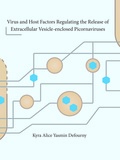Virus and Host Factors Regulating the Release of Extracellular Vesicle-enclosed Picornaviruses

Defourny, Kyra
- Promoter:
- Prof.dr. M.H.M. (Marca) Wauben & prof.dr. F.J.M. (Frank) van Kuppeveld
- Co-promoter:
- Dr E.N.M. (Esther) Nolte
- Research group:
- Kuppeveld , Extracellular vesicles in the context of viral and bacterial infections , Wauben
- Date:
- March 30, 2023
- Time:
- 12:15 h
Summary
To exchange information cells participate in the continuous exchange of small, membranous particles termed “extracellular vesicles” (EVs). These EVs carry status updates and instructions to neighbors, and can be compared to the cellular equivalent of sending an email or posting messages on social media. Although cell-to-cell communication via EVs is typically beneficial, these messages have the potential to turn corrupted during the development of disease. In the last years, a growing number of viruses were found capable of hiding in the EVs shuttled between cells. Similar to an email carrying a computer virus, the packaging of viruses within EVs enables viruses to bypass our body’s defenses by adopting a seemingly harmless exterior, and provides an alternative method for virus spread. In this dissertation, it was investigated how EV production of cells changes in response to virus infection and which proteins produced by the virus and the host cell regulate this process. Our data uncovers a previously unknown level of heterogeneity among the virus-containing EVs that are released during infection. We show that the spread of viruses via EVs is enhanced by drastic changes in the number and type of EVs that a cell produces, along with the activation of new EV-cargo sorting pathways. Finally, we demonstrate that these changes in EV production are the result of the interplay between the activity of dedicated viral proteins and cellular stress responses. These results provide novel insight into the virus-host interactions that determine the amount and phenotype of virus-carrying EVs released during infection.